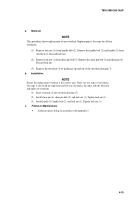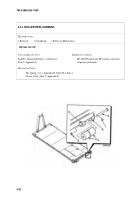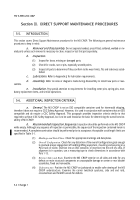TM-9-3990-260-14-P - Page 121 of 306
TM 9-3990-260-14&P
Change 1
5-3
(5)
A-frame Assembly.
Check for any distortion of the A-frame assembly great enough to pre-
clude safe movement using the PLS truck and trailer. Check for excessive wear of the front
pins and rear pins. Excessive wear of these items requires their replacement. Check bail
bar for excessive wear or cracks in weldment.
(6)
Deck.
Check condition of deck floor for defects. Check storage boxes in deck for service-
ability and availability of BII.
(7)
Deck Flooring Gaps.
Excessive gaps in flooring may be determined by use of a 1 inch
(2.54 cm) wide by 1/16 inch (1/59 mm) thick feeler gauge. Any suitable strip of metal may
be used.
c.
Suggested Tools and Equipment.
(1)
Straight Edge.
A wire, string or other form of a straight edge is needed to determine
whether any portion of the M3 CROP protrudes past the outside surfaces of the side rails,
which would interfere with M3 CROP insertion and extraction from an ISO shipping con-
tainer.
(2)
Measuring Tape (Ruler).
A measuring tape (ruler) is required to check dimensional toler-
ances.
(3)
Welder’s Hammer.
A welder’s hammer (NSN 5120-00-240-3096 or equivalent) is helpful
in determining the strength of welds or metal structural components.
(4)
Inspection Stands.
Jackstands (Item 4, Appendix I) provide a safe means for supporting the
empty M3 CROP to enable proper viewing of the M3 CROP understructure. DoD person-
nel should also refer to service-specific safety guidelines about “Working Under a Sus-
pended Load”.
(5)
Flashlight.
A flashlight improves visual acuity, especially during examination of the
recesses of the understructure.
(6)
Chalk.
Marking (circling) location of defects with chalk as they are discovered facilitates
preparation of inspection reports and helps maintenance personnel locate areas to be
repaired.
d.
Primary Structural Components.
An M3 CROP with any major defect in any component
of its primary structure is unacceptable. For purposes of this criteria, primary (main) structural components (mem-
bers) include: twistlock housings, A-frame assembly, roller assembly brackets, forklift pockets and main rails.
(1)
Main Defects.
A major defect includes:
(a)
A dent or bend in any primary structural component that prevents the CROP for load-
ing.
(b)
A crack, break, cut, tear, puncture or corrosive failure in any primary structural com-
ponent.
(c)
A missing, cracked or broken weld at the juncture between any primary structural
component.
(d)
More than two splices or an improper splice of any one floor crossmember.
(e)
Any damage or degradation within a component that could place any person in dan-
ger during subsequent handling, stacking or transport of the M3 CROP.
(f)
More than one splice or an improper splice (such as a lapped splice) in an end rail.
Back to Top




















